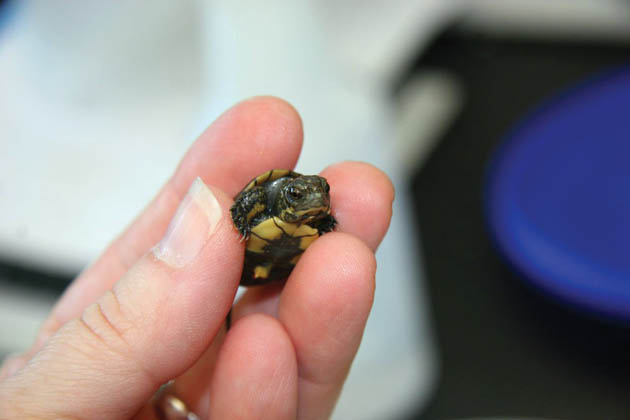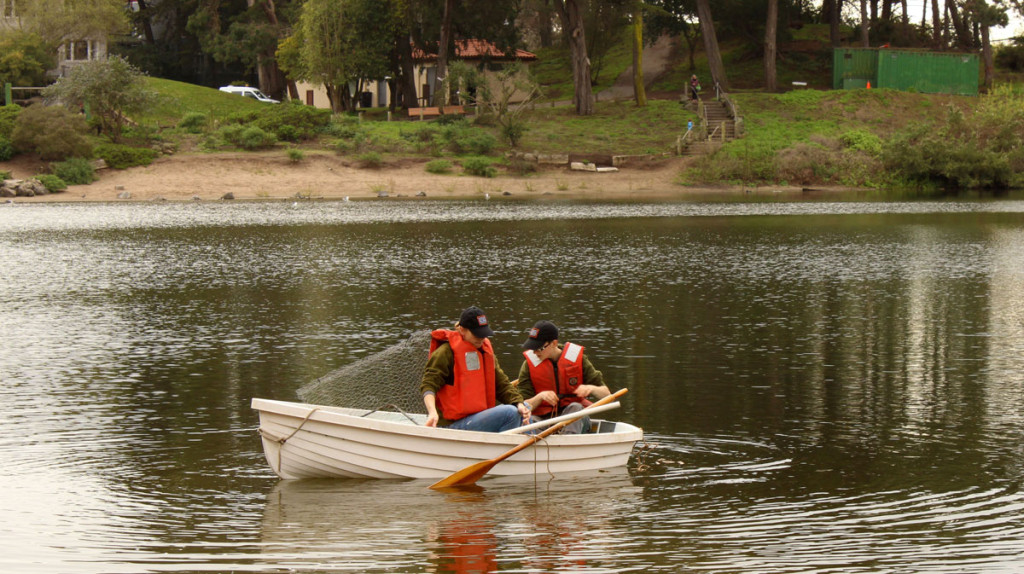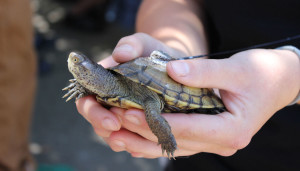Jason Lisenby likens his planting process to working with cookie dough. Standing along the south shore of Mountain Lake in San Francisco’s Presidio, he reaches into a large green bucket for a handful of clay and small stones, then adds a bit of water and sand from the lake to soften up the mix.
Next he drops the “chocolate chips”—about 50 sago pondweed seeds —into his recipe and kneads the muddy concoction into a ball in his hand. He sloshes into the lake in his tall black wading boots, drops his mud ball into the shallow water, and watches it sink.
A few American coots swim by, their eyes on the underwater gardening project. “They can’t wait for the buffet to open,” says Lisenby, a biological science technician for the Presidio Trust.
If Lisenby and other biologists can keep the hungry birds and fish away for long enough, these sprouts will grow into a robust garden of underwater plants that will form the base of the healthy aquatic ecosystem he and others are working to restore in long-disturbed Mountain Lake.

Submerged aquatic vegetation, or SAV, as scientists refer to these critical underwater plants, is not the most charismatic category of flora. But once fully grown, the pondweed and a number of other target plants will serve as food and habitat for the next stage of the restoration process, the return of the native fish, mussels, insects, turtles, and birds that once resided in and around this natural lake in the southwestern corner of the Presidio.
One of the few natural bodies of water on the San Francisco peninsula, four-acre Mountain Lake was, for several thousand years, a 30-foot-deep lake that provided fresh drinking water for Ohlone Indian inhabitants and European settlers. But in the 19th and 20th centuries it filled with sediment and debris from nearby construction, in particular the creation of Highway 1 and the southern approach to the Golden Gate Bridge. The busy road also contributed a heavy load of toxic pollution to the lake, and by the 1970s Mountain Lake was no more than 10 feet deep and incapable of supporting a healthy suite of native species.
In 2001, the Presidio Trust, the federal agency created to preserve and protect the former military base, started the process of rehabilitating the lake by removing nonnative vegetation from around the shoreline and replanting it with natives. More recently, the trust began the process of restoring the lake itself by dredging about 15,600 cubic meters of sediment from the bottom, removing toxins and increasing the average depth to about 15 feet.
Now, with the lake once again clean enough to support native species, the managers are reintroducing the basic building blocks of a healthy ecosystem. Enter submerged aquatic vegetation.
Sounds simple. But no one knew which plants to use here, nor how to go about propagating and planting them. So it has been a learning experience for the Presidio Trust staff every step of the way, from consulting with specialists to building a new facility to propagate the seeds to figuring out how best to plant them.
Since March 2014, Lisenby and his colleagues have planted sago pondweed seeds and turions (the plant’s overwintering bud stage) in 13 locations around the lake. In August, ecologists also began introducing water milfoil, water nymph, floating pondweed, and leafy pondweed to the two main planting sites near the lake’s shallow north arm and south shore.
Finding the right native aquatic plants to cultivate for this project has been a challenge, says Michele Laskowski, a seed collection ecologist for the Presidio Nursery and Golden Gate National Parks Conservancy, which also supports the work of the Presidio Trust at Mountain Lake. “We’ll find a record, sometimes more than 100 years old, [indicating] that a particular species was in the lake at a particular time,” Laskowski says. “So we’re just following clues and hoping we find what we’re looking for.”
Her team has planted seeds from species collected from several water bodies in San Francisco and Marin, including Rodeo Lagoon, Lake Lagunitas, Abbotts Lagoon, El Polin, and the Sutro Baths.
Establishing a healthy crop of aquatic plants is critical to bringing back such Mountain Lake native species as the Western pond turtle, says Nicholas Geist, a Sonoma State University biology professor who is working with the San Francisco and Oakland zoos on a project to bolster the turtle’s dwindling population in the wild. Geist and his colleagues are looking to a healthy Mountain Lake as a first potential home for the turtles they have been breeding at the zoos.

The San Francisco Zoo now has 67 hardy turtles and plans to release all of them in Mountain Lake in late spring or early summer, says Jessie Bushell, an assistant curator at the zoo. They will be two to three years old when they are released, although they are about the size of four–year-old turtles now because of their protected upbringing. “They are like the mascot for this restoration,” she adds.
The plan is for the turtles and the vegetation to take hold after the demise of what’s been the biggest hurdle to the project: wildly invasive carp and largemouth bass that until this winter had overrun the lake. Likely the descendants of released private aquarium fish, the nonnative carp uprooted aquatic plants and stirred up sediment in the water. In November, workers with the Presidio Trust dropped 47 gallons of rotenone, a widely used fish-killing toxicant, into the lake to try and rid it of the fish that, if left to proliferate unimpeded, would snack on future baby turtles. The plant-based toxin does not affect the newly planted SAV.
By late November, the Presidio Trust was reporting success, with nearly 1,000 dead fish removed, mostly carp.
The carp had been in the lake for about 50 years, says Jonathan Young, a San Francisco State biology graduate student who has been working with the Presidio Trust since 2012 to try to remove the fish. In the two years before the rotenone was used, Young manually pulled about 20,000 juvenile carp and bass out of the water. Ecologists will check the lake’s health again in the spring before reintroducing the turtles, as well as native fish and chorus frogs. “Obviously, with the carp and bass removed, the lake will be healthier and more productive, which means more of an invertebrate food source for the turtles,” Young says. The restoration has many moving parts: removing toxins, capturing carp, and nurturing threatened turtles. But for now, the future of Mountain Lake is being built one muddy, sago-pondweed-seed-filled “chocolate chip” ball at a time.





-300x225.jpg)